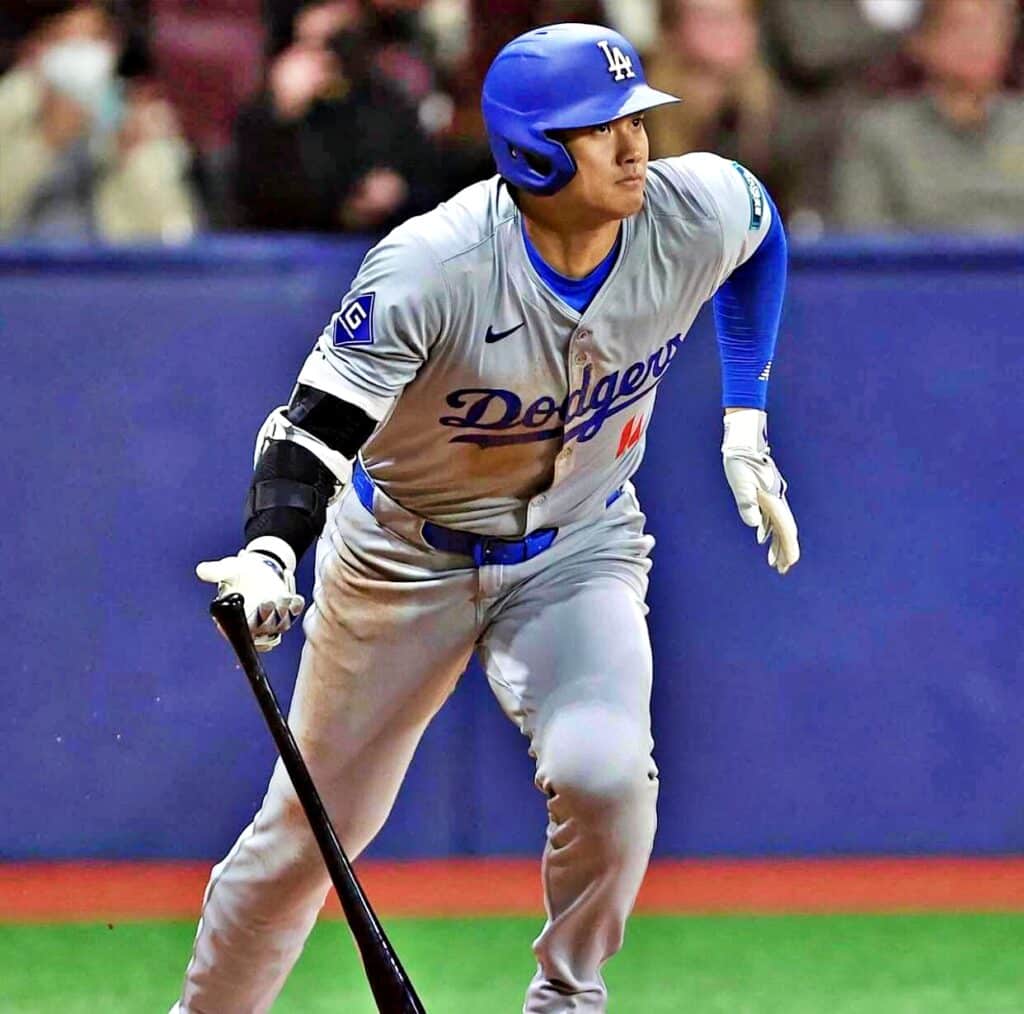
After two months of play – one-third of the way through the regular season – we have the report cards on Japanese import players in Major League Baseball.
Shohei Othani of the Los Angeles Dodgers has continued to pay early dividends on his record-setting contract, and pitcher Shota Imanaga of the Chicago Cubs has made a brilliant start to his MLB career. Starter Yusei Kikuchi of the Toronto Blue Jays and reliever Yuki Matsui of the San Diego Padres have had good starts to their seasons, while the early results from highly touted Dodger pitcher Yoshinobu Yamamoto and veteran Padres starter Yu Darvish have been mixed. Outfielder Seiya Suzuki of the Boston Red Sox was on the Injured List for a while, and his performance since returning has not matched his strong start. Starter Kenta Maeda of the Detroit Tigers and outfielder Masataka Yoshida of the Boston Red Sox started slowly and then spent time on the Injured List, and starting pitcher Kodai Senga of the New York Mets has yet to pitch because of a stint on the Injured List.
Shohei Ohtani
Ohtani continued to move along on his own rarefied level during May. OK, so he didn’t get a hit in every game like one might expect by now. But he got enough to average .312, get on base at a .385 clip, and slug .591 while hitting seven homers and driving in 19 runs.
Overall, he’s averaging .326 – his best start since he came to MLB with the Los Angeles Angels in 2018 – and he’s also been more aggressive on the bases. His career high for stolen bases is 26 in 2021, but he’s already stolen 13 in the first two months of this season and has yet to be thrown out.
But can we nitpick? Of course, we can.
He had a bit of a falloff in late May, getting just five hits in his last 30 at bats.
He’s also had less success than expected with runners in scoring position (RISP), though he did improve in this category as the month continued. From 2021 to 2023, Ohtani was one of Major League Baseball’s best hitters with RISP. He batted .305 in those situations, the 22nd-best mark in the majors in that span. As of May 4, his average in those situations was just .184, but he raised that to .254 by the end of the month. At that time, he was averaging .336 with the bases empty and .315 with runners on base but not in scoring position.
On the pitching side, Ohtani continues to make progress in his recovery from Tommy John surgery. He began throwing when the Dodgers returned from their season-opening series against San Diego in Seoul and has advanced to throwing from 60 feet. Some of the throws have reached 80 miles per hour. The plan is still to have him return to the mound in 2025.
As an amusing aside, his teammates played a prank on him May 22 that momentarily worked. As Ohtani was preparing for an at-bat against the Arizona Diamondbacks, utility player Miguel Rojas told Ohtani he was pinch-hitting for him. Ohtani looked stunned. It took him a few moments to realize Rojas was just pulling his leg.
Shōta Imanaga

Imanaga was overshadowed by Yamamoto in free agency, but he’s taken the pitching spotlight so far. As with all imports, the question was how well and quickly he could make the adjustment to MLB. So far, at least, he’s answered the question superbly.
Though his string of nine quality starts to begin the season was snapped on May 29 by Milwaukee, Imanaga has done far better than perhaps anyone expected at the beginning of his MLB career. In his first nine starts, he had five scoreless outings and allowed more than one run just twice.
Because of a rainout in St. Louis on May 25 when he had been scheduled to start, and because the Cubs are closely managing his total innings pitched in his first MLB season, he did not start between May 17 and May 29 when he started against Milwaukee. After allowing eight hits – two home runs – and seven earned runs to the Brewers, his season marks “ballooned” to 1.86 and 1.00, respectively. He’s 5-1 for the season and has walked just 10 batters in 58 innings.
Imanaga has given the Cubs’ rotation a huge boost with offerings that include a low-to-mid-90s fastball, splitter, slider, and curve. He was even rated No. 1 in the Starting Pitcher Power Rankings in late May.
Jim Bowden of The Athletic notes that “He’s done it with a 91-93 mph fastball at the top of the zone and a wipeout split-finger that gets strikeouts in and out of the zone. Incredibly, he has both an elite chase percentage (97%) and walk percentage (97%) to start the year.”
Yusei Kikuchi
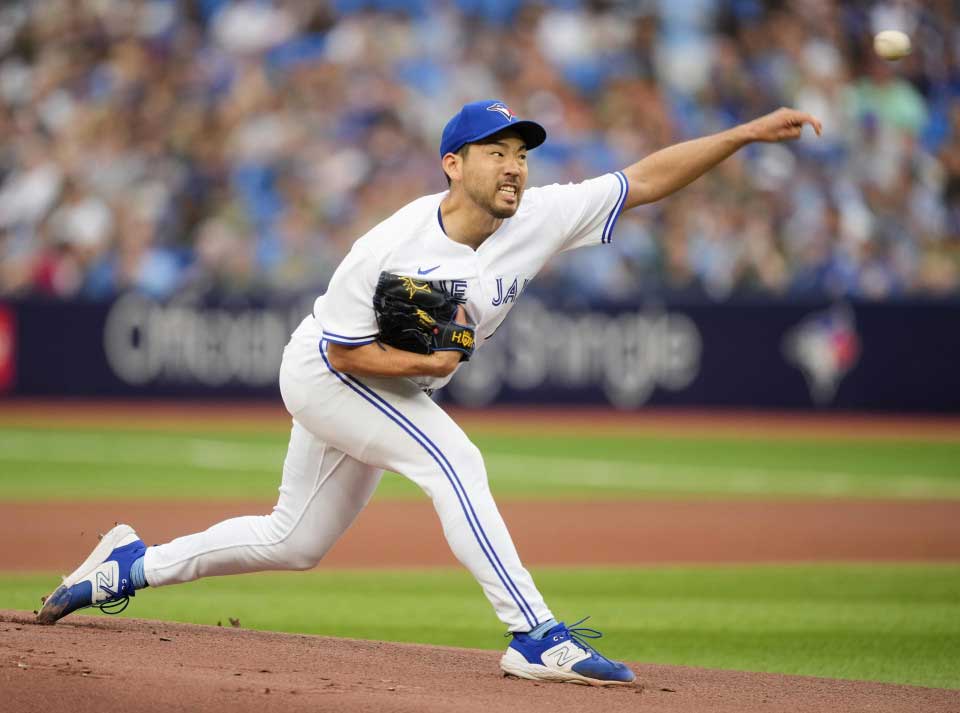
Overall, Kikuchi continued to show the improvement that began in 2023. After a strong April, he had four solid starts to begin May, allowing just six earned runs in 24 innings. He then gave up eight hits and five earned runs in three innings against Detroit on May 26.
For the month, he was 0-2 with a 3.62 ERA and continued to have better command, walking just five batters in 27.1 innings. Overall, he is 2-4 with a 3.25 earned-run mark and is averaging less than two walks per game. His best mark in his previous five seasons was 2.6 per nine innings in 2023.
At this point, he is also allowing an average of just 0.7 home runs per nine innings, which compares favorably to his career mark of 1.6 per nine.
Kikuchi being consistently a top performer will enhance Toronto’s chances of again making the playoffs, as well as his bargaining position after his contract expires at the end of this season.
Yoshinobu Yamamoto
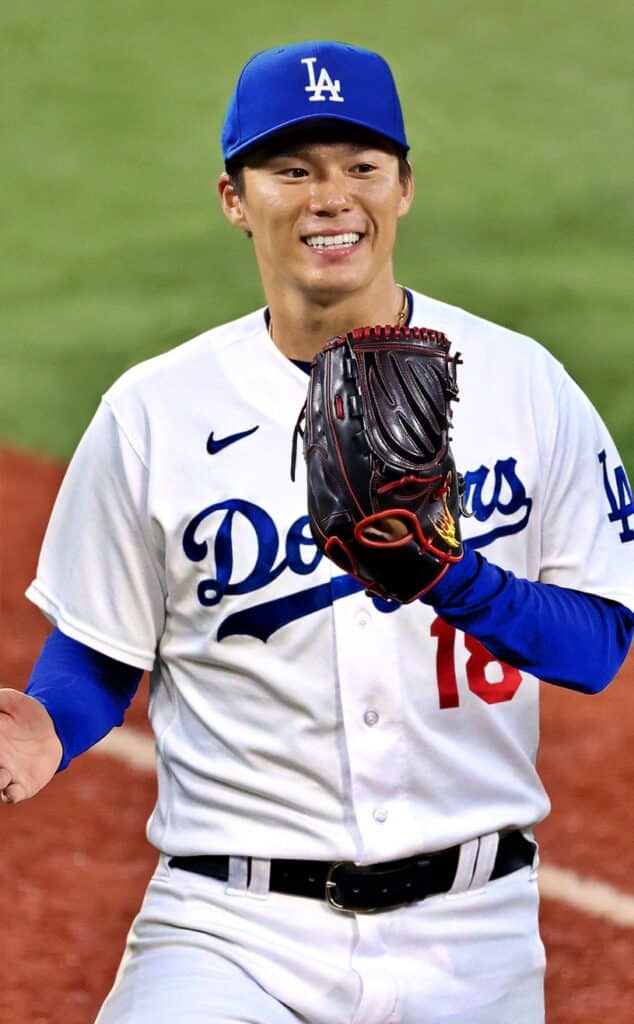
The Dodgers signed Yamamoto to a 12-year, $325 million contract, hoping he can anchor their rotation for years to come. Since he’s just 25 years old, there is a good chance that he can be effective for most of the length of his contract.
After an April in which he posted a 2.45 ERA and 1.05 WHIP, he was 3-1 with a 3.48 ERA and 1.13 WHIP in May. He had three solid outings and two others in which he allowed 11 hits, four walks, and eight earned runs in 10.2 innings.
Like all import players, he’s had to adjust to a new culture, much more travel, a new baseball, different opposing hitters, and more. Plus, there is the weight of expectations that fall to anyone who has a contract as large as his. The Dodgers are letting him start every sixth or seventh day, as he did in Japan, and he appears to be handling the transition well. His statistics remain good, even including his disastrous first start against the Padres in Korea.
He’s averaging 10.5 strikeouts, 7.9 hits, 2.0 walks, and 0.9 home runs per nine innings. Opposing batters are averaging just .229 with an on-base percentage of only .272 and a .379 slugging percentage. For the season, he is 5-2 with a 3.51 ERA, but his FIP (fielding independent pitching) mark is an excellent 2.82.
“It’s been fascinating to watch him kind of handle all the extra pressure and everything that comes with it,” assistant pitching coach Connor McGuiness said recently. “To go out and do what he’s done — I think this is only the beginning of it, too. I think he’s going to keep getting better and better.”
Dodger first baseman Freddie Freeman said, “It feels like every time he goes out, everyone expects him to throw a complete-game shutout. That’s a lot on him. So for him to go out there and do what he’s been doing these first two months, I think it’s special.”
Yu Darvish
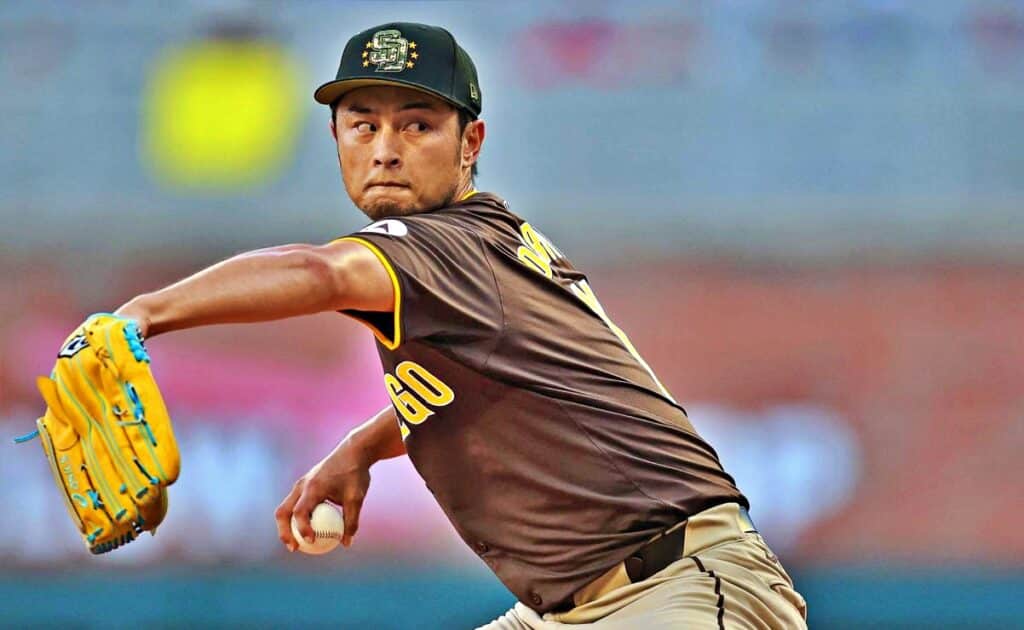
After undergoing a minimally-invasive arthroscopic debridement in his pitching elbow during the offseason, he had a reasonably good, if inconsistent April, and he followed that with a very solid May.
He was 3-2 in May with a 2.93 earned-run average despite his sub-optimal last two outings. On May 24, he gave up four home runs and seven earned runs in 5.2 innings to the Yankees, and he lasted just three innings against Miami on May 29. However, before that, he notched a career-best 25 consecutive scoreless innings.
The highlight of Darvish’s month was recording his 200th career win between MLB and NPB on May 19. He notched the “W” in style, pitching seven shutout innings against the Atlanta Braves. He now only trails Hiroki Kuroda (203) and Hideo Nomo (201) on the combined wins list, and he is likely to pass them this year if he stays healthy.
After coming off the Injured List (neck tightness) on April 30, he did not allow an earned run in his four starts prior to the debacle against New York.
“I think it is the command,” Padres manager Mike Shildt said. “I think it’s the life to his pitches and the finish to his pitches. The fastball has got the velocity that we’ve seen in the past, with the life we’ve seen, and the secondary pitches have the right bite. He’s throwing it where he wants to, so he’s in a really good spot.”
After the first two months of the season, Darvish is 4-3 with a 3.20 ERA and 1.07 WHIP. He is allowing 2.4 walks per nine innings, which, if continued throughout the season, would be the second-best of his career.
Yuki Matsui
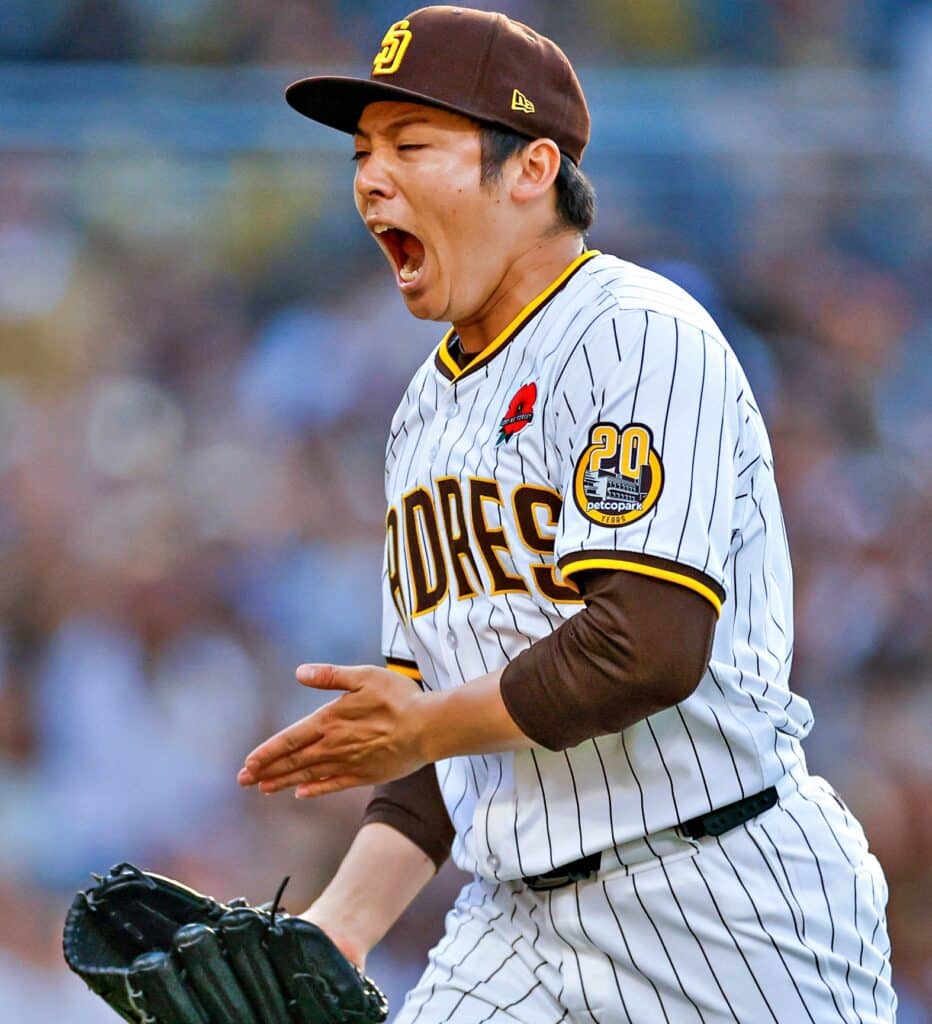
Matsui, a 28-year-old lefthanded reliever in his first MLB season, missed much of spring training with back issues, throwing only three innings, but he has been solid for the Padres in the regular season. In May, he had a stretch of three games in which he gave up four earned runs in 2.2 innings, but he then did not allow a run in his final seven outings of the month.
At the end of May, he stands at 3-0 with a 2.88 earned-run mark. He’s given up just one home run and only 15 hits in 25 innings, though his walk rate is quite high at 5.04/9 innings. Though a lefthander, he’s been tough on righthanded hitters, allowing them just a .154 average. Lefthanders, meanwhile, have hit only .226 off him.
Matsui mixes his pitches well – a fastball that ranges into the mid-90s, a splitter, curve, and slider. Reportedly, the slider averages 31 inches of vertical and 24 inches of horizontal movement.
Though Matsui was a closer in Japan, he’ll begin in setup situations with the Padres while he adjusts to MLB. He has yet to come in as a closer for San Diego.
Seiya Suzuki
Like Kikuchi, Suzuki took steps in the right direction during 2023 and continued to do so in April 2024 before hitting the Injured List on April 15 because of an oblique injury.
Suzuki returned to the lineup on May 11 and batted just .219 the rest of the month with only two home runs and six RBI. He did seem to pick up the pace somewhat late in the month, though, with six hits in his last 19 at bats. On-base percentage was .415 in April but just .275 in May.
Whether the oblique injury is still causing issues isn’t certain. However, Suzuki has especially struggled with off-speed stuff. Despite being the pitch he sees the least, Suzuki is swinging at exactly half the off-speed pitches he sees and whiffing at 46.7 percent of them. He’s chasing them at a 32.4 percent clip. In the first two months, he was making contact with 76% of the pitches he swung at, according to FanGraphs – a drop from his 80.8 rate of a year ago.
Kenta Maeda
The 35-year-old Maeda signed a two-year, $24 million deal with Detroit in the off-season. The Tigers, who finished with a 78-84 record in 2023 and were a game under .500 at the end of May, need him to be the pitcher he was in the second half of last season if they are to contend this year.
So far, though, it hasn’t worked out that way, though he showed flashes in May.
Overall, Maeda is 2-2 with a 6.25 earned-run average and 5.83 FIP. After a difficult April, he began the new month with six innings against the St. Louis Cardinals, giving up just four hits and one run. However, in his next start against Cleveland, he allowed five hits, three walks, and seven earned runs in just two innings.
He was then placed on the Injured List on May 11 because of a viral illness and wasn’t re-activated until May 24. He faced Toronto that day and was solid, giving up just four hits over five scoreless innings.
[Against Toronto] “He was really deceptive,” Detroit manager A.J. Hinch said. “He never really threw the same pitch twice in a row. He looked like he had them off balance. He got some miss hits. He was creative in his pitches. He threw late-count fastballs, which were good, and I think he had pretty good feel for his off-speed, which is always key for him.”
However, he followed that with a 4.2-inning stint against Boston in which he allowed five earned runs.
Masataka Yoshida
So far in 2024, Yoshida hasn’t been what the Red Sox need, though he did go 5-7 in his last two games of April to boost his average to .275 with a .736 OPS. He had been in a 3-18 funk prior to those two games.
However, he was placed on the Injured List on April 29 with a left thumb sprain after jamming his hand during an at bat the previous night, and he hasn’t played since.
There is concern that he could be out for some time. Reportedly, he had his thumb examined multiple times to determine if surgery was necessary, and the decision was “no”. But he has been fully shut down and has not taken part in baseball activities recently, according to Chris Cotillo of MassLive. The Red Sox will re-evaluate Yoshida’s hand in ‘a few weeks’”
Kodai Senga
Senga suffered a setback early in spring training when he was diagnosed with a moderate right posterior capsule strain and received a platelet-rich plasma (PRP) injection. He was eventually placed on the 60-day IL, and he was projected to return to the mound in late May. The timetable now has been extended, as it’s likely that he will not be back before the All-Star break.
Senga didn’t throw at all for nearly a month. Beginning in late March, he threw off flat ground for approximately five weeks before throwing a very successful live batting practice session on April 29. He threw all his pitches during the session and reached the mid-90s with his fastball. But Senga deliberately slowed his progress to work on his mechanics. He then began experiencing triceps discomfort and nerve inflammation severe enough that he had a cortisone injection in mid-May.
“When your muscles are not moving the way they’re supposed to, a lot of different things can get inflamed,” Senga said. “It happened to be the nerve this time.”
“I think we’ve got a pretty frustrated player here that he’s not able to contribute to the team,” Mendoza said. “We know how much he wants to be out there and helping the team — and right now, he’s not capable of doing so.”
In 2023, the first of a five-year, $75 million deal, Senga posted a 2.98 ERA with 202 strikeouts in 166 1/3 innings. He was named an All-Star, placed second in the National League Rookie of the Year voting, and finished seventh in NL Cy Young voting.
Interestingly, Senga needs to pitch at least 400 innings from 2023-2025 to be able to opt out of his contract at the end of the 2025 season. At the moment, he has just the 166.2 from last season.
NOTES: Righthanded reliever Naoyuki Uwasawa, who signed a minor-league contract in the off-season with the Tampa Bay Rays after nine seasons with the NPB’s Nippon Ham Fighters, was traded to Boston on March 28 for cash and immediately assigned to the Red Sox’ AAA Worcester, MA, affiliate. He was called to the big club at the end of April and made his MLB debut with two clean innings May 2 against San Francisco. The next day, he allowed a couple of hits and two walks in two innings against Minnesota. On May 8, he was returned to Worcester, he is 2-2 with a 6.32 ERA in 31.1 innings . . . Reliever Shintaro Fujinami was a late-spring demotion by the Mets. A year ago, his pitchers were measured at as high as 102.6 MPH, but he walked an average of 5.1 batters per nine innings. Currently playing at AAA Syracuse, Fujinami’s command issues have continued. In nine appearances covering 7.2 innings, he’s walked 17 batters, an average of, yes, nearly 20 batters per nine innings . . . Infielder Yoshi Tsutsugo, who had stints in the Tampa Bay, Los Angeles Dodger, Pittsburgh, and San Francisco organizations without much success, is back in Japan with his former team, the Yokohama DeNA Baystars. He’s averaged .250 with the Baystars and also appeared in six games with their minor-league affiliate . . . And, catching up with some other recent imports who are back in Japan – outfielder Shogo Akiyama (Cincinnati) has a .2856/.319/.349 slash line with the Hiroshima Toyo Carp; reliever Hirokazu Sawamura (Boston) is 1-0 with a 4.50 ERA in 12 innings with the Chiba Lotte Marines; and pitcher Kohei Arihara (Texas) is 5-3 with a 1.84 ERA in nine starts with the Fukuoka Softbank Hawks.

